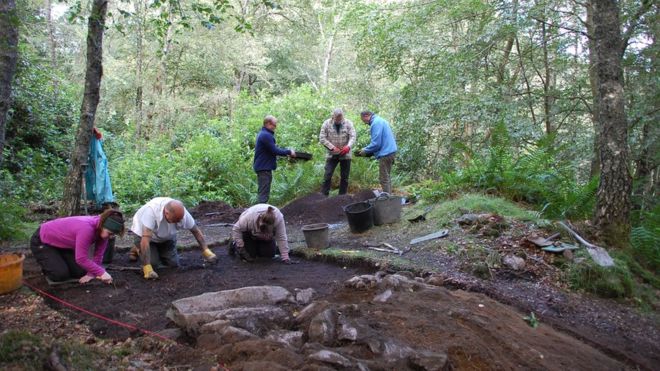Ancient ‘power centre’ uncovered in Perthshire, Scotland
A hilltop fort near Dunkeld was an important Pictish power centre, say archaeologists who excavated the site. Evidence of metal and textile production were revealed at King’s Seat Hillfort, a legally protected site.
Finds such as glass beads and pottery suggested the Picts who occupied the site in the 7th to 9th centuries had trade links with continental Europe.
Other finds included pieces of Roman glass that were recycled and reused as gaming pieces.
In a new report on last year’s excavations, archaeologists said the wealth of finds suggested the site had been a stronghold of the elite in the local population, with “influence over the trade and production of high-status goods”.
Fragments of pottery – of the kind made in continental Europe – and Anglo-Saxon glass beads suggested the Picts were trading far afield. As well as evidence of metal-working, spindle whorls used in textile production were found.

Archaeologists said the artefacts uncovered were in keeping with other high-status, royal sites of early historic Scotland, including the early Dalriadic capital of Dunadd in Argyll and the Pictish royal centre of Dundurn near St Fillan’s by Loch Earn.
Perth and Kinross Heritage Trust (PKHT) worked with Dunkeld and Birnam Historical Society, archaeological contractors AOC Archaeology Ltd on the digs.
Thirty community volunteers and Pitlochry High School students assisted with the excavations.
Last year’s work marked the third and final season of excavations as part of the King’s Seat Hillfort Community Archaeology Project. The site is a scheduled ancient monument and digs can only be done with prior permission.

David Strachan, director of PKHT, said: “We have uncovered lots of evidence of how people were living and working, and the remains of a building with a large hearth on the summit, with fragments of glass drinking vessels, gaming pieces, animal bone and horn.
“They paint a vivid picture of high-status people gathering and feasting, decorated in the latest high-status jewellery and ornamentation.”
Cath MacIver, of AOC Archaeology, said crucibles, whetstones, stone and clay moulds found indicated that craft production took place at the hillfort.
“What’s particularly interesting is that evidence of this activity has been found in all of the trenches [excavated areas],” she said.
“There must have been a lot of iron and other metalworking going on here making the site an important centre for production – not just the home of a small group of people making items for their own use.”

